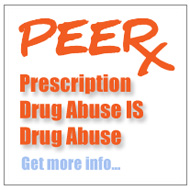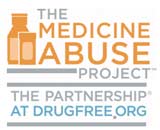Prescription Drugs
Emerging Drugs
Get more information on K2/Spice, Salvia and Bath Salts. NIDA will update this page with the latest research findings on these and other emerging drugs as they develop.
Commonly Abused Drugs
What is Prescription Drug Abuse?
Prescription drug abuse means taking a prescription drug that is not prescribed for you, or taking it for reasons or in dosages other than as prescribed. Abuse of prescription drugs can produce serious health effects, including addiction.
Commonly Abused Drugs
Commonly abused classes of prescription drugs include opioids (for pain), central nervous system (CNS) depressants (for anxiety and sleep disorders), and stimulants (for ADHD and narcolepsy).
Opioids include:
- Hydrocodone (Vicodin®)
- Oxycodone (OxyContin®)
- Oxymorphone (Opana®)
- Propoxyphene (Darvon®)
- Hydromorphone (Dilaudid®)
- Meperidine (Demerol®)
- Diphenoxylate (Lomotil®)
Central nervous system depressants include:
- Pentobarbital sodium (Nembutal®)
- Diazepam (Valium®)
- Alprazolam (Xanax®)
Stimulants include:
- Dextroamphetamine (Dexedrine®)
- Methylphenidate (Ritalin® and Concerta®)
- Amphetamines (Adderall®)
Street Names
| Name | Slang |
|---|---|
| Xanax | Z-bar, Bricks, Benzos |
| Oxycodone | Oxy’s, Hillbilly Heroin, Dope, 40s, 20s, 80s |
| Valium | Blues |
| Ritalin | Vitamin R, Rid, Rittys, Rits |
| Adderall | Beans, Black Beauties, Speed, Uppers |
| Vicodin | Vike |
| Percocet | Percs |
| Sedatives and Tranquilizers | Chills Pills, French Friends, Tranqs |
Effects
Long-term use of opioids or central nervous system depressants can lead to physical dependence and addiction. Opioids can produce drowsiness, constipation and, depending on amount taken, can depress breathing. Central nervous system depressants slow down brain function; if combined with other medications that cause drowsiness or with alcohol, heart rate and respiration can slow down dangerously. Taken repeatedly or in high doses, stimulants can cause anxiety, paranoia, dangerously high body temperatures, irregular heartbeat, or seizures.
Statistics and Trends
In 2009, 16 million Americans age 12 and older had taken a prescription pain reliever, tranquilizer, stimulant, or sedative for nonmedical purposes at least once in the year prior to being surveyed. Source: National Survey on Drug Use and Health (Substance Abuse and Mental Health Administration Web Site). The NIDA-funded 2010 Monitoring the Future Study showed that 2.7% of 8th graders, 7.7% of 10th graders, and 8.0% of 12th graders had abused Vicodin and 2.1% of 8th graders, 4.6% of 10th graders, and 5.1% of 12th graders had abused OxyContin for nonmedical purposes at least once in the year prior to being surveyed. Source: Monitoring the Future (University of Michigan Web Site).
Related Publications
Related NIDA Notes Articles
-
Drug Abuse at Highest Level in Nearly a Decade (December 2010)
-
Substance Abuse Evaluated Among Women With Children (December 2010)
-
Adolescent Cigarette Smoking Holds at Lowest Recorded Levels (October 2010)
-
James A. Inciardi (1939-2009) (April 2010)
Related News Releases
-
NIDA creates easy-to-read website on drug abuse (February 2012)
-
Cigarette and alcohol use at historic low among teens (December 2011)
-
Painkiller Abuse Treated by Sustained Buprenorphine/Naloxone (November 2011)
-
Buprenorphine treatment in pregnancy: less distress to babies (December 2010)
Other Resources
- MEDLINEplus Health Information on Drug Abuse - National Library of Medicine, NIH
- www.abovetheinfluence.com - Office of National Drug Control Policy
- healthfinder.gov - U.S. Department of Health and Human Services
Past information on many drugs of abuse is available on our Archives site.
Tags
Looking for Treatment?
Use the SAMHSA Treatment Locator or 1-800-662-HELP.
Featured Publication
Drugs, Brains, and Behavior - The Science of Addiction
As a result of scientific research, we know that addiction is a disease that affects both brain and behavior.
 External link, please review our disclaimer.
External link, please review our disclaimer.  External link, please review our disclaimer.
External link, please review our disclaimer.  External link, please review our disclaimer.
External link, please review our disclaimer.  External link, please review our disclaimer.External link, please review our disclaimer.
External link, please review our disclaimer.External link, please review our disclaimer. 













